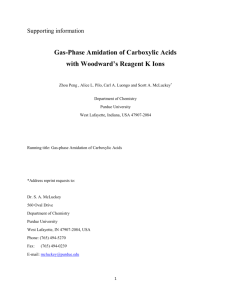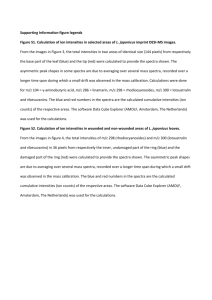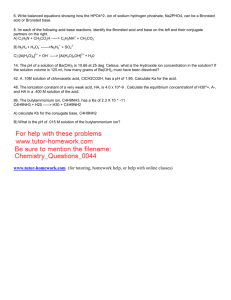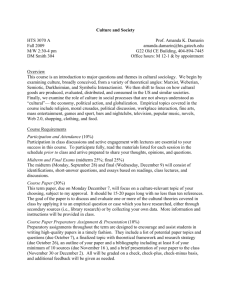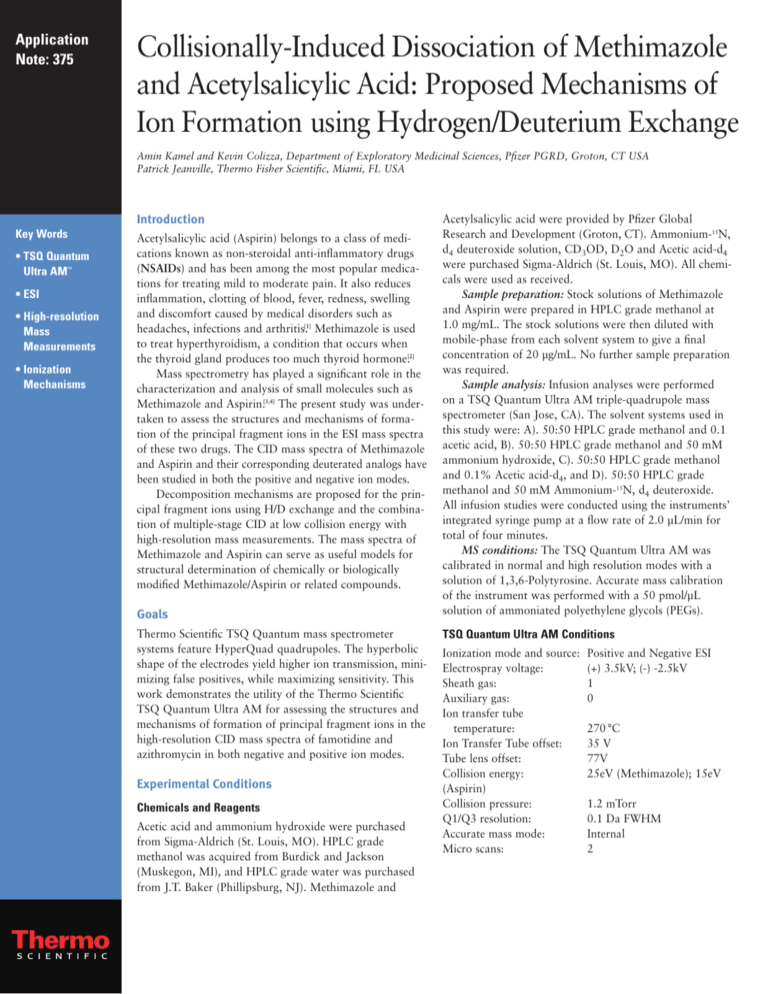
Application
Note: 375
Collisionally-Induced Dissociation of Methimazole
and Acetylsalicylic Acid: Proposed Mechanisms of
Ion Formation using Hydrogen/Deuterium Exchange
Amin Kamel and Kevin Colizza, Department of Exploratory Medicinal Sciences, Pfizer PGRD, Groton, CT USA
Patrick Jeanville, Thermo Fisher Scientific, Miami, FL USA
Introduction
Key Words
• TSQ Quantum
Ultra AM™
• ESI
• High-resolution
Mass
Measurements
• Ionization
Mechanisms
Acetylsalicylic acid (Aspirin) belongs to a class of medications known as non-steroidal anti-inflammatory drugs
(NSAIDs) and has been among the most popular medications for treating mild to moderate pain. It also reduces
inflammation, clotting of blood, fever, redness, swelling
and discomfort caused by medical disorders such as
headaches, infections and arthritis.[1] Methimazole is used
to treat hyperthyroidism, a condition that occurs when
the thyroid gland produces too much thyroid hormone.[2]
Mass spectrometry has played a significant role in the
characterization and analysis of small molecules such as
Methimazole and Aspirin.[3,4] The present study was undertaken to assess the structures and mechanisms of formation of the principal fragment ions in the ESI mass spectra
of these two drugs. The CID mass spectra of Methimazole
and Aspirin and their corresponding deuterated analogs have
been studied in both the positive and negative ion modes.
Decomposition mechanisms are proposed for the principal fragment ions using H/D exchange and the combination of multiple-stage CID at low collision energy with
high-resolution mass measurements. The mass spectra of
Methimazole and Aspirin can serve as useful models for
structural determination of chemically or biologically
modified Methimazole/Aspirin or related compounds.
Goals
Thermo Scientific TSQ Quantum mass spectrometer
systems feature HyperQuad quadrupoles. The hyperbolic
shape of the electrodes yield higher ion transmission, minimizing false positives, while maximizing sensitivity. This
work demonstrates the utility of the Thermo Scientific
TSQ Quantum Ultra AM for assessing the structures and
mechanisms of formation of principal fragment ions in the
high-resolution CID mass spectra of famotidine and
azithromycin in both negative and positive ion modes.
Experimental Conditions
Chemicals and Reagents
Acetic acid and ammonium hydroxide were purchased
from Sigma-Aldrich (St. Louis, MO). HPLC grade
methanol was acquired from Burdick and Jackson
(Muskegon, MI), and HPLC grade water was purchased
from J.T. Baker (Phillipsburg, NJ). Methimazole and
Acetylsalicylic acid were provided by Pfizer Global
Research and Development (Groton, CT). Ammonium-15N,
d4 deuteroxide solution, CD3OD, D2O and Acetic acid-d4
were purchased Sigma-Aldrich (St. Louis, MO). All chemicals were used as received.
Sample preparation: Stock solutions of Methimazole
and Aspirin were prepared in HPLC grade methanol at
1.0 mg/mL. The stock solutions were then diluted with
mobile-phase from each solvent system to give a final
concentration of 20 µg/mL. No further sample preparation
was required.
Sample analysis: Infusion analyses were performed
on a TSQ Quantum Ultra AM triple-quadrupole mass
spectrometer (San Jose, CA). The solvent systems used in
this study were: A). 50:50 HPLC grade methanol and 0.1
acetic acid, B). 50:50 HPLC grade methanol and 50 mM
ammonium hydroxide, C). 50:50 HPLC grade methanol
and 0.1% Acetic acid-d4, and D). 50:50 HPLC grade
methanol and 50 mM Ammonium-15N, d4 deuteroxide.
All infusion studies were conducted using the instruments’
integrated syringe pump at a flow rate of 2.0 µL/min for
total of four minutes.
MS conditions: The TSQ Quantum Ultra AM was
calibrated in normal and high resolution modes with a
solution of 1,3,6-Polytyrosine. Accurate mass calibration
of the instrument was performed with a 50 pmol/µL
solution of ammoniated polyethylene glycols (PEGs).
TSQ Quantum Ultra AM Conditions
Ionization mode and source:
Electrospray voltage:
Sheath gas:
Auxiliary gas:
Ion transfer tube
temperature:
Ion Transfer Tube offset:
Tube lens offset:
Collision energy:
(Aspirin)
Collision pressure:
Q1/Q3 resolution:
Accurate mass mode:
Micro scans:
Positive and Negative ESI
(+) 3.5kV; (-) -2.5kV
1
0
270 °C
35 V
77V
25eV (Methimazole); 15eV
1.2 mTorr
0.1 Da FWHM
Internal
2
ciation step, followed by the elimination of HCN (Figure
5). The fragment ion NCS– at m/z 58 is also observed.
For protonated aspirin (Figure 1), elimination of
H2O (Figure 6) and the acetyl group (CH2CO) were the
major decomposition pathways (Figure 7). The CID mass
spectrum of [M-H]– of aspirin (Figure 8) was much simpler
and showed the loss of CH2CO at m/z 137 as the primary
dissociation pathway (Figure 9). The ensuing elimination
of CO2 from the fragment ion at m/z 137 was a minor
dissociation pathway.
Results
CID of protonated methimazole (Figure 1) exhibits
primary dissociations via eliminations of HCN and H2S
(Figure 2). Supplementary losses of CH3, S and C2H3N
are minor dissociation pathways from [M+H]+ ion.
Proposed mechanistic decompositions from the [M+H]+
ion are given in Figure 3 and corroborate well with the
empirical data. The CID mass spectrum of [M-H]– ion
(Figure 4) shows loss of methyl group as the initial disso-
OH
O
H
N
O
N
S
N
O
SH
N
Methimazole
Acetylsalicylic Acid
Figure 1: Structures of Methimazole and Acetylsalicylic acid (aspirin)
[M+H-H2S]+
81.0950
100
90
Relative Abundance
80
[M+H]+
70
115.0650
60
50
40
+
[M+H-S]
[M+H-C2H3N]+
100.0450
88.0550
30
20
[M+H-CH3]+
[M+H-HCN]+
83.1100
74.0600
10
0
70
75
80
85
90
95
100
105
110
115
m/z
[M(d1)+D]+
100
117.0500
90
Relative Abundance
80
70
60
[M(d1)+D-DCN]+
50
40
[M(d1)+D-HCN]+
89.0200
30
90.0600
20
[M(d1)+ D-C2H3N]+
10
76.0700
[M(d1)+D-CH3]+
+
[M(d1)+D-S]
101.9800
85.0700
0
70
75
80
85
90
95
100
105
110
115
m/z
Figure 2: Positive ion ESI mass spectra of Methimazole (MW= 114): CID product ion spectra (MS/MS) of [M+H]+ at m/z 115 and the fully
exchanged [M(d1)+D]+ at m/z 117. Deuteration was achieved by liquid phase H/D exchange method. MS and MS/MS experiments were
performed on a TSQ Quantum Ultra AM mass spectrometer.
Page 2 of 6
pKa (MA) = 12.37
(D)
pKa (MB) = -3.35
H
+ H (D)
N
H
N
S
(D)
(D)
H
H
+ N
H (D) transfer
S
N
S
..
N
N
m/z = 115 (117)
H
m/z = 115 (117)
N
pKa (MB) = -1.65
+
N+
H
S
S
migration of H-2
(D)
H
H
H (D)
N
H (D)
H
N
H
m/z = 115 (117)
m/z = 115 (117)
- HCN
- HCN (DCN)
N+
H
H
H
N+
H
S
(D)
(D)
m/z = 88 (89)
H
S
H (D)
m/z = 88 (90)
Figure 3: Proposed CID fragmentation mechanisms for the major fragment ions from protonated Methimazole at m/z 115 determined from H/D
exchange patterns, high-resolution mass measurements and MS/MS experiments. Numbers in parentheses refer to deuterated fragment ions
[M-H]113.0200
100
Relative Abundance
90
80
[M-H-CH3]-
70
98.0300
60
50
[M-H-N=C=S]-
40
58.0650
30
[M-H-S]-
20
81.0900
10
0
35
40
45
50
55
60
65
70
75
80
85
90
95
100
105
110
115
m/z
[M(d1)-D]113.0400
100
90
[M(d1)-D-CH3]-
Relative Abundance
80
70
98.0300
60
50
[M(d1)-D-N=C=S]-
40
58.0600
30
[M(d1)-D-S]-
20
81.0900
10
0
35
40
45
50
55
60
65
70
75
80
85
90
95
100
105
110
115
m/z
Figure 4: Negative ion ESI mass spectra of Methimazole (MW= 114): CID product ion spectra (MS/MS) of [M-H]– at m/z 113 and the fully
exchanged [M(d1)-D]– at m/z 113. Deuteration was achieved by liquid phase H/D exchange method. MS and MS/MS experiments were
performed on a TSQ Quantum Ultra AM mass spectrometer.
Page 3 of 6
-
-
N
S
N
-Me
S
m/z = 98
N
N
m/z = 113
.
.
N
+
-N
S
S-
N
m/z = 58
N
N
H
.
.
N
N
H
S
-
m/z = 98
m/z = 98
.
H +
N
..
H
S
H
H
N
-
H
S
.
N
S
m/z = 71
Figure 5: Proposed CID fragmentation mechanisms for the major fragment ions from
deprotonated Methimazole at m/z 113 determined from H/D exchange patterns, highresolution mass measurements and MS/MS experiments
[M+H]+
181.0125
100
90
O
Relative Abundance
80
70
O
60
O
50
40
[M-H-H2O]+
O
163.0125
30
HO
20
10
144.9825
120.9900
0
105
110
115
120
125
130
135
140
145
150
155
160
165
170
175
m/z
Figure 6: Positive ion ESI mass spectra of acetylsalicylic acid (MW= 180): CID product ion spectrum (MS/MS) of [M+H]+ at m/z 181.
MS and MS/MS experiments were performed on a TSQ Quantum Ultra AM mass spectrometer
Page 4 of 6
180
pKa (MB) =NA
H
pKa (MA) = 3.48
H
H
+O
O
O
H
O H
O
+O
H
H
H
O
H
O
H
H
O
O
O
m/z = 181
O
m/z = 181
- CH 2 CO
- H 2O
Value calculated by AC D lab
H
O +
C
H
H
+O
O
H
O
OH
H
O
m/z = 139
m/z = 163
- CH 2 CO
- H 2O
O +
C
OH
m/z = 121
Figure 7: Proposed CID fragmentation mechanisms for the major fragment ions from protonated Acetylsalicylic Acid at m/z 181 determined
from high-resolution mass measurements and MS/MS experiments
[M-H]178.9834
100
90
Relative Abundance
80
-H
70
60
50
O
O
40
30
[M-H-CO2]-
20
135.0572
10
[M-H-H2O]-
109.0953
161.0090
0
105
110
115
120
125
130
135
140
145
150
155
160
165
170
175
180
m/z
[M(d1)-D]179.0734
100
90
Relative Abundance
80
70
[M(d1)-D-CO2]-
60
134.9872
50
40
30
[M(d1)-D2O]-
20
10
160.8791
109.5351
0
105
110
115
120
125
130
135
140
145
150
155
160
165
170
175
180
m/z
Figure 8: Negative ion ESI mass spectra of acetylsalicylic acid (MW= 180): CID product ion spectra (MS/MS) of [M-H]– at m/z 179 and the
fully exchanged [M(d1)-D]– at m/z 179. Deuteration was achieved by liquid phase H/D exchange method. MS and MS/MS experiments were
performed on a TSQ Quantum Ultra AM mass spectrometer.
Page 5 of 6
In addition to these
_
O
offices, Thermo Fisher
O
O
H
O
H
_
_
H
O
H
O
- CH2CO
- CO2
H
_
O
O
a network of representative organizations
throughout the world.
O
m/z = 179
Scientific maintains
m/z = 137
m/z = 93
Figure 9: Proposed CID fragmentation mechanisms for the major fragment ions from deprotonated acetylsalicylic acid at m/z 179 determined
from H/D exchange patterns, high-resolution mass measurements and MS/MS experiments
Conclusions
Protonated methimazole dissociates primarily through
elimination of HCN. Loss of CH3, S, and C2H3N are
minor dissociation pathways from [M+H]+ ion. The CID
mass spectrum of [M-H]– ion show loss of methyl group
as the initial dissociation step followed by the loss of
HCN. The fragment ion NCS at m/z 58 is also observed.
For protonated aspirin, elimination of H2O and
acetyl group (CH2CO) were the two major competitive
decomposition pathways. The CID mass spectrum of the
[M-H]- of aspirin was much simpler and showed the loss
of CH2CO at m/z 137 as the primary dissociation pathway. Subsequent elimination of CO2 from the fragment
ion at m/z 137 was a minor fragmentation pathway.
The TSQ Quantum Ultra AM Mass Spectrometer
system was designed to provide superior performance,
while maintaining a level of flexibility not available on
similar platforms.
References
1
Litovitz TL, Klein-Schwartz W, White S, Cobaugh DJ, Youniss J, Omslaer
JC, Drab A, Benson BE (2001). “2000 Annual report of the American
Association of Poison Control Centers Toxic Exposure Surveillance
System.” Am J Emerg Med 19 (5): 337-95.
2
Sgarbi, Jose A.; Villaca, Fabio G.; Garbeline, Benito; Villar, Heloisa E.;
Romaldini, Joao H. Journal of Clinical Endocrinology and Metabolism
(2003), 88(4), 1672-1677.
3
Mongillo, J.A.; Paul, J. Microchemical Journal (1997), 55(3), 296-307.
4
Reszka, Krzysztof J.; Wagner, Brett A.; Teesch, Lynn M.; Britigan, Bradley
E.; Spitz, Douglas R.; Burns, C. Patrick. Cancer Research (2005), 65(14),
6346-6353.
5
Kamel, A.M.; Brown, P.R.; Munson, B. Anal. Chem. 1999, 71(5), 968-977.
6
Kamel, A.M.; Brown, P.R.; Munson, B. Anal. Chem. 1999, 71(24), 54815492.
• HyperQuad electrodes enabled acquisition of mass
spectra at resolutions below 0.2 Da FWHM, without
a significant reduction in signal response.
• High-resolution CID mass spectra were acquired using
the TSQ Quantum Ultra AM mass spectrometer system
of the fully-exchanged species. The high-resolution mass
measurements aided greatly in structural assignments of
fragment ions.
• The mass spectra of Methimazole and aspirin can serve
as useful models for structure determination of chemically or biologically modified Methimazole and aspirin
or related compounds.
Africa
+43 1 333 5034 127
Australia
+61 2 8844 9500
Austria
+43 1 333 50340
Belgium
+32 2 482 30 30
Canada
+1 800 530 8447
China
+86 10 5850 3588
Denmark
+45 70 23 62 60
Europe-Other
+43 1 333 5034 127
France
+33 1 60 92 48 00
Germany
+49 6103 408 1014
India
+91 22 6742 9434
Italy
+39 02 950 591
Japan
+81 45 453 9100
Latin America
+1 608 276 5659
Middle East
+43 1 333 5034 127
Netherlands
+31 76 587 98 88
South Africa
+27 11 570 1840
Spain
+34 914 845 965
Sweden / Norway /
Finland
+46 8 556 468 00
Switzerland
+41 61 48784 00
UK
+44 1442 233555
USA
+1 800 532 4752
www.thermo.com
Legal Notices
©2007 Thermo Fisher Scientific Inc. All rights reserved. All trademarks are the property of Thermo Fisher Scientific Inc. and its subsidiaries. This information
is presented as an example of the capabilities of Thermo Fisher Scientific Inc. products. It is not intended to encourage use of these products in any manners
that might infringe the intellectual property rights of others. Specifications, terms and pricing are subject to change. Not all products are available in all
countries. Please consult your local sales representative for details.
View additional Thermo Scientific LC/MS application notes at: www.thermo.com/appnotes
Thermo Fisher Scientific,
San Jose, CA USA is ISO Certified.
AN62501_E 11/07S
Part of Thermo Fisher Scientific




